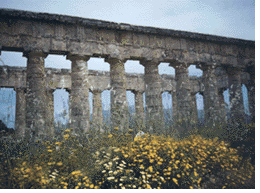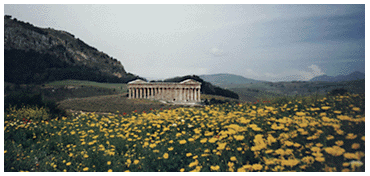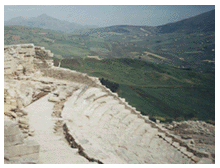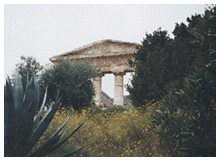...Best of Sicily presents... Best of Sicily Magazine. ... Dedicated to Sicilian art, culture, history, people, places and all things Sicilian. |
by Daniele Dionisio | |||||
Magazine Best of Sicily Arts & Culture Fashion Food & Wine History & Culture About Us Travel Faqs Contact Map of Sicily
|
Built around 430 BC, the Doric temple is the focal point of Segesta, its grandeur all the more glorious in Spring, when wild flowers blossom in the surrounding fields. One easily imagines ancient (but young) Segestan girls gathering poppies, snapdragons and daisies on the graceful slopes. By mid June, the field grasses and flowering shrubs (by then called "weeds") are already amber and brown, not from lack of rain but from timeless habit. It is a metamorphosis deigned by the gods. The greyish limestone of this most singular of ancient cities assumes, in a subtle way, the color of its surroundings – from green to gold highlights.
Medieval chronicles all but ignore Segesta, and to ancient ones she is little more than a footnote to epic conflicts. In places like Segesta, certain things seem to have changed little in many centuries. Paestum has grassy fields, Agrigento almond groves, and Segesta its flowers. Tranquil testaments to time and nature. What became of the Segestans? Nearby Calatafimi was essentially an Arab city of mosques and veiled women. Still, it is probable that the medieval Segestans abandoned their city for nearby towns such as Erice (Eryx). The ancient sculpture of Segesta leaves us with an idealized impression of a healthy, attractive people. For the Segestans, the magical change of seasons was a divine act of gods. For us, it's something to be experienced anew each year.
About the Author: Archeologist Daniele Dionisio is an employee of the European Commission who presently divides his time between Calatafimi and Atlanta (USA). | ||||
Top of Page |


 Nobody knows precisely who they were, or even what to call them – Elami, Elimi,
Elymians – but by the time they were Hellenized, probably around 500 BC (BCE), their city of
Nobody knows precisely who they were, or even what to call them – Elami, Elimi,
Elymians – but by the time they were Hellenized, probably around 500 BC (BCE), their city of  At a
diameter of around sixty-two meters, the amphitheatre is not very
large but still impressive. It offers a high vantage point from which to view the valleys.
At a
diameter of around sixty-two meters, the amphitheatre is not very
large but still impressive. It offers a high vantage point from which to view the valleys.
